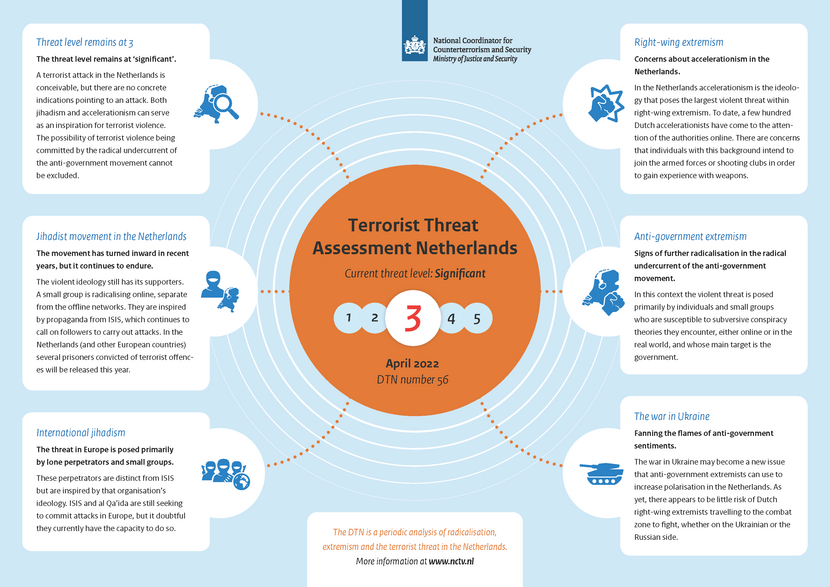NCTV Terrorist Threat Assessment: threat of terrorist attack remains conceivable, but there are no specific indications of one
At present, there are no concrete indications pointing to a terrorist attack in the Netherlands, though it is conceivable. For this reason the threat level has been maintained at 3 (on a scale of 1 to 5). These are the key conclusions of the 56th edition of the Terrorist Threat Assessment for the Netherlands, published by the National Coordinator for Counterterrorism and Security (NCTV). Supporters of jihadism pose the greatest terrorist threat to the Netherlands, although Dutch jihadists have little if any public presence. Vigilance is also necessary with regard to right-wing extremism, as some young adherents may pose a threat. There are also indications of further radicalisation within the radical undercurrent of the movement opposing the government’s coronavirus measures. In this context the violent threat is posed primarily by individuals and small groups who are susceptible to subversive conspiracy theories they encounter, whether online or in the real world.
The jihadist movement in the Netherlands
Over the past two years the jihadist movement in the Netherlands has become largely inward-looking. In recent years there have been fewer and fewer public expressions of jihadists ideology, whether online or in the real world. This is in part a consequence of government intervention. Most jihadists in the Netherlands are part of offline networks. A small group is radicalising online, distinct from the offline networks. They take their inspiration from the propaganda put out by ISIS, which continues to call on its supporters via official and non-official media channels to carry out attacks independently.
In 2022 a number of individuals convicted of terrorist offences are due to be released from prison in the Netherlands and in other Schengen countries, including several men and women convicted of travelling to Syria and Iraq to wage jihad. Although many of the released prisoners will in all likelihood not make new plans to commit terrorist crimes, a small number of them will probably present a heightened threat after their release.
The threat posed by the jihadist movement in Europe has been relatively stable for some time. The threat in Europe is mainly constituted by lone perpetrators and small groups or cells, which are separate from ISIS but are inspired by that organisation and/or its ideology. The means of attack used are usually relatively simple. The number of jihadist attacks in Europe in 2021 was significantly lower than in 2020.
Right-wing extremism
As established in the previous threat assessment, accelerationism is the movement that poses the largest violent threat within the sphere of right-wing extremism. A few hundred Dutch accelerationists have come to the attention of the authorities online; some of them may pose a threat. In several of this movement’s online networks a fascination with weapons has been noted. There are concerns that individuals with this ideological background intend to join the armed forces or shooting clubs in order to gain experience with weapons. A new factor is that the war in Ukraine may exert an appeal on Dutch right-wing extremists, but as yet they have shown little interest in travelling to Ukraine and joining right-wing extremist groups on either the Ukrainian or the Russian side.
Anti-government extremism
In the Netherlands, discontent about the coronavirus measures mostly took the form of activities undertaken by a law-abiding upper layer and a radical undercurrent. Certain utterances by public figures may give individuals in this radical undercurrent a sense of being heard and legitimated in their radical behaviour. A small number of individuals contributing to the political discourse have employed a radicalised COVID-19 narrative involving various conspiracy theories. Virologists have indicated that there is still a risk of new coronavirus variants emerging, meaning there may be a resurgence of actions by the radical undercurrent if restrictive measures are reintroduced. Agitators and conspiracy theorists are also likely to shift their focus to other issues in society on which they oppose the government.
